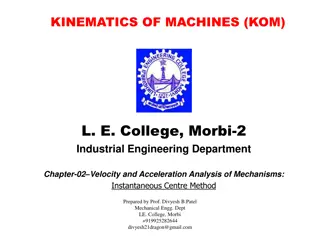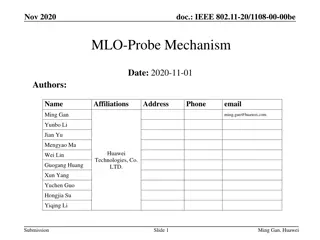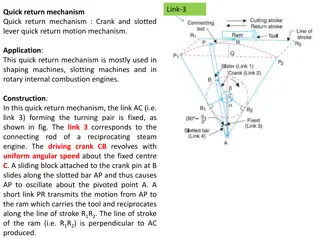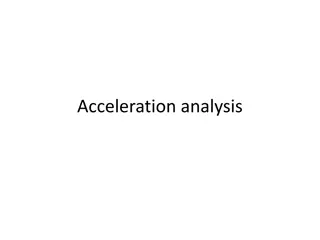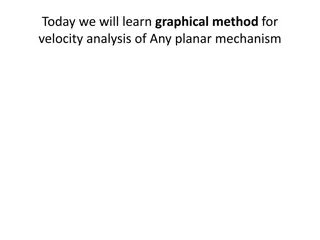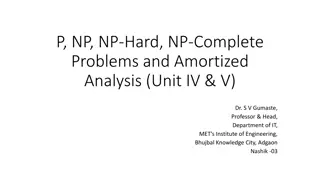Understanding Slider Crank Mechanism: Practice Problems and Solutions
Explore a practice problem based on a slider crank mechanism, involving calculations for velocity of the slider, velocity of a point on the connecting rod, and angular velocity. Detailed steps and solutions provided to understand the concepts clearly.
Download Presentation

Please find below an Image/Link to download the presentation.
The content on the website is provided AS IS for your information and personal use only. It may not be sold, licensed, or shared on other websites without obtaining consent from the author. Download presentation by click this link. If you encounter any issues during the download, it is possible that the publisher has removed the file from their server.
E N D
Presentation Transcript
Practice problem-1 based on today class.
Practice problem -1: In a slider crank mechanism, the crank is 480 mm long and rotates at 20 rad/s in the counter-clockwise direction. The length of the connecting rod is 1.6 m. When the Crank turns 600 from the inner-dead centre, determine the (i) Velocity of the slider (answer : 9.7 m/s) (ii) Velocity of a point E located at a distance 450 mm on the connecting rod extended (answer : 10.2 m/s) (iii) Angular velocity of the connecting rod (answer: 3.28 rad/s clockwise)
A 1.6 m 104.940 20 rad/s 600 15.060 o B OA = 480 mm In OAB, AB = 1.6 m Velocity of point A Magnitude VA = OA x OA = 0.48 x 20 = 9.60 m/s Direction Velocity of A is perpendicular to OA Angle B = 15.06 degree Angle A = 180 60 15.06 = 104.94 degree
VA 14.940 A 1.6 m 75.060 104.940 15.060 600 o VB B Velocity component of A along AB = VA Cos ( 14.940 ) Velocity component of B along AB = VB Cos ( 15.060 ) Velocity component of A along AB = Velocity component of B along AB VA Cos ( 14.940 ) = VB Cos ( 15.060 ) VB = 9.6 x Cos ( 14.940 ) / Cos ( 15.060 ) = 9.605 m/s
DIRECTION PERPENDICULAR TO AB VA 14.940 A 1.6 m 75.060 104.940 15.060 600 o VB B Velocity component of A perpendicular to AB = VA Sin ( 14.940) = 9.6 x Sin ( 14.940) DIRECTION PERPENDICULAR TO AB Velocity component of B perpendicular to AB = VB Sin ( 15.060) = 9.605 x Sin ( 15.060) Angular velocity of Link AB = (VA Sin ( 14.940) + VB Sin ( 15.060) ) / AB = 3.11 rad/s
Velocity of E along AB , Vex = Velocity of A along AB = Velocity of B along AB. m/s Velocity of A along AB ,VEx = = VA Cos ( 14.940 ) = 9.28 m/s VA sin ( 14.940 ) =2.47 m/s VB sin ( 15.060 ) =2.50 m/s VEy VAy = 2.47 m/s 1.6 m 0.45 m B E A Vby = 2.5 m/s m/s m/s








